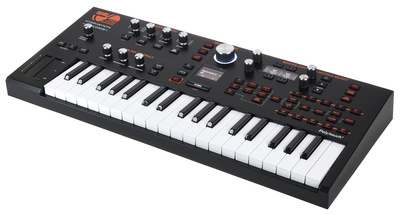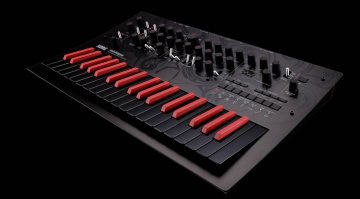The Best Synths for Beginners: Buying Your First Synth
Ready to buy your first synth but don’t know what to get? We’re looking at some of the best synths for beginners to quicken your creative pulse and inspire your first case of GAS.
Choosing the best synths for beginners
You never forget your first. Synthesizer, that is. Whether you’re a seasoned in-the-box producer ready to take your first steps into the hardware world, or you’re a newbie looking to get your feet wet, there’s nothing like buying your first synth.
With so many instruments on the market, and all of them different, it can be tough to know where to start. I’ve been there myself, so I know what you’re going through.
With that in mind, I’ve put together a list of five instruments of varying synthesis types and prices. There are no modules here – all of them have keys to make getting started that much easier. Just crack open the box, plug it in, and get started making music.
Arturia MiniBrute 2 Noir
Traditionally, keyboard players of old learned their synth chops on a monophonic analogue. Think Moog Minimoog, Roland SH-101 or Korg MS-20.
Monosynths (they play one note at a time) are great for two reasons: they’re generally more affordable than polyphonic synthesizers (they can play chords) plus they’re an excellent way to learn subtractive synthesis.
For the newbie who’s not sure what they’re doing, Arturia’s MiniBrute 2 (now in the all-black Noir edition) makes a solid starting point. With two VCOs (oscillators), a characterful filter, two envelopes for adjusting sound over time, two LFOs, and plenty of ways to distort your sound, the MiniBrute 2 is an excellent way to learn how to make sounds with synthesizers.
It also has plenty of patch points to take your sounds to new places once you’re ready.
- More from Arturia


Korg Minilogue XD
If a single note at a time is too limited for your first synth, or you want something beyond just pure analogue, take a look at Korg’s hybrid, four-voice Minilogue XD. It has a very modern, clean analogue sound courtesy of two VCOs (analogue oscillators) with the additional bonus of a digital oscillator.
The multi-engine oscillator can do noise, FM, and wavetable, and is also open source, meaning third-party developers can make plugin-style engines for it.
Sound-shaping possibilities continue with a two-pole filter with drive circuit for extra grit, two envelopes and an LFO, and a lovely digital effects section with delay, reverb and modulation.
It also has a polyphonic step sequencer with motion recording so you can capture knob tweaks in your sequences. The Minilogue XD is applicable to many different genres but I find it’s particularly suited for electronic music.
- More from KORG


ASM Hydrasynth Explorer
One of the amazing things about getting into synthesizers now is there are so many different kinds to choose from. Analogue, FM, wavetable, sampling – as long as your credit card holds out you can have it all. So far we’ve looked at analogue and hybrid synth.
Next is the all-digital Hydrasynth Explorer from Ashun Sound Machines. It’s the most affordable of the company’s Hydrasynth range and an excellent candidate for your first synth.
A wavetable synth on steroids, Hydrasynth Explorer lets you combine, twist and mangle sampled waveforms in all kinds of weird and wild ways. There are three oscillators for thick sounds, two filters (yes, two), and plenty of other synthesis shapers.
However (and most importantly), it sounds jaw-droppingly gorgeous. Although it’s all digital, you’ll be wondering how it can sound so smooth. It also supports fully polyphonic aftertouch, something the players will love and almost unheard of at this price point.
- More from ASM


Sequential Take 5
Few synthesizer manufacturers are as revered as Sequential. That reverence also comes with a high price tag.
Usually, that is. The Take 5 is the company’s most wallet-friendly instrument and while it’s not as full-featured as some of the company’s other instruments (particularly when it comes to the keyboard), it will still get you that Sequential sound – and at around half the price.
As the name suggests, Take 5 is a five-voice synth. Analogue, it features two VCOs per voice, a lowpass filter borrowed from the company’s flagship Prophet-5, two five-stage envelopes, and two LFOs, plus a comprehensive effects section.
It’s also got an arpeggiator and polyphonic step sequencer and – most importantly – that Sequential mojo. If you’re serious about your music and have the means, consider the Take 5 for your first synth.
- More from Sequential


Roland Jupiter-Xm
For the producer used to the convenience of a DAW and plugins, being stuck with just one instrument may seem limiting. If this is your concern, you may want something like Roland’s Jupiter-Xm for your first synth.
Roland’s CEO Jun-ichi Miki conceptualized the Jupiter-Xm as a portable synthesizer studio, and with that in mind, it can do a lot. Its basic Jupiter-X synthesizer engine is powered by ZEN-Core, meaning you can swap sounds that you create with the plugin instrument, Zenology.
There are also model emulations of classic Roland synths like the SH-101 and Juno-106, with more available on the Roland Cloud store. Not enough? You can also layer all these sounds together into massive combinations.
Additionally, it has drum sounds from the TR-808, TR-909, and others, a ton of effects, an AI-equipped arpeggiator, and more. With its USB audio, you can even use it as an audio interface, meaning you can record all of the different layers independently in your DAW and effectively build entire tracks from just the one synth.
- More from Roland


More about the best synths for beginners:
- All about synthesizers
- More for beginners
Videos:
*Note: This article contains promotional links that help us fund our site. Don’t worry: the price for you always stays the same! If you buy something through these links, we will receive a small commission. Thank you for your support!
- Arturia MiniBrute 2 Noir: Arturia
- Korg Minilogue XD: Korg
- ASM Hydrasynth Explorer: ASM
- Sequential Take 5: Sequential
- Roland Jupiter-Xm: Roland
5 responses to “The Best Synths for Beginners: Buying Your First Synth”

 4,6 / 5,0 |
4,6 / 5,0 | 


















a wonderful article for a newbie ..me.. full of definitions for homework and fun stuff
no microfreak?
when starting out for less than 500 bucks, novation Bass station 2 is hard to beat (not just for bass), and when it come to modules, the behringer pro-1 is a very versatile and easy to use.
Reface CS
My choice out of those would be the Hydrasynth Exp, though the others are all good synths too. The Hydrasynth can do analogue sounding, digital/FM, soundtrack, weird stuff, percussion etc. Note, it does not have a sequencer unlike some of the others, but it does have a good arpeggiator. Though I don’t think a beginner could go far wrong with any of the ones listed. Also, you can still buy a new Microkorg (simple to use), Bass Station 2 (as stated by other comment), and Modal’s Cobalt 8 is also great, but perhaps a little too complex for a first synth.